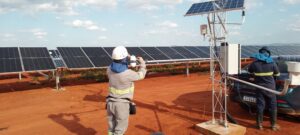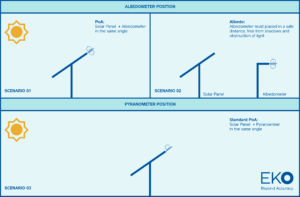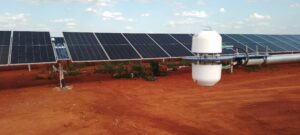Albedo, Albedometers, and Pyranometers: The Hidden Light That Powers Solar Energy

Albedometers installation performed by our partners RoMiotto, in Brazil.
What is Albedo and How Do We Measure It?
Imagine standing in a snowy field on a bright day – you can almost feel the sunlight bouncing off the ground into your face. That reflected light is albedo at work. It’s the light that doesn’t get absorbed by the ground but instead finds its way back up. Albedo is a measure of how much sunlight a surface reflects, and it’s always changing: the sun moves, shadows shift, and the ground changes with dust, water, or snow, these changes can swing solar yield predictions as ground reflections can be more than 80%- 90%*

That’s where albedometers come in to be able to measure solar irradiance on both sides of the PV module. Picture two smart sensors (like the MS-80SH pyranometers from EKO) working as a team – one looks up, one looks down – measuring the light coming in and the light bouncing back. Together, they give you the real picture.
Why Albedo Matters for the Solar Industry
Albedo isn’t just some technical detail. For bifacial solar panels, the light reflected off the ground feeds the back of the panels, helping you squeeze out more energy. A ground that’s brighter or more reflective can mean a real jump in power output.
Albedo, the measure of surface reflectivity, varies significantly throughout the year due to changes in ground properties and environmental conditions. Vegetation, snow cover, soil moisture, and surface roughness all influence albedo values. Atmospheric factors like cloud cover and air pollution can also affect the amount and quality of reflected solar radiation. Seasonal variations, such as snow in winter or dry soil in summer, cause noticeable changes. A key factor is the solar angle: when the sun is low on the horizon, reflection is more diffuse and albedo increases. Accurate measurement requires continuous monitoring to capture these dynamic changes over time.
If you don’t measure albedo right, you risk designing plants that underperform or fail to hit their promised numbers. Getting it right means better designs, better forecasts, and happier investors.
Optimal Pyranometer Placement for Albedo Measurement
Good data starts with smart placement. The upward and downward pyranometers positioned in horizontal plane need to be level, at the same height (usually 1.5 – 2 meters up), and far enough from panels so they’re not shaded or picking up glare. It sounds simple, but many get it wrong: we’ve seen sensors too close to panels, or mounted at an angle, giving a skewed view of the site’s reflectivity. A simple diagram can help teams get it right – showing the dos and don’ts of pyranometer setup.
Under-Module Pyranometer Setup
When installing a pyranometer underneath a PV module—typically for albedo or bifacial irradiance measurements—optimal positioning is critical to ensure representative and accurate data. For bifacial PV systems, the pyranometer should be aligned in the same orientation and tilt angle as the PV modules but placed just beneath the rear side of the module at or near the center of a typical row. This ensures it measures the irradiance reflected from the ground that would impact the rear side of the PV module. It’s essential to avoid shadowing from module frames, but might be difficult to avoid. To ensure accurate measurements, the mounting height should be consistent with the lowest point of the module to simulate similar view factors. The surrounding ground should represent the typical surface of the entire installation (e.g., grass, gravel, snow) to ensure spatial relevance.
The Growing Importance of Albedometers
As bifacial PV becomes the new standard, albedometers have moved from nice-to-have to must-have. EKO’s MS-80SH-based systems are trusted on big solar farms from Europe to the Middle East. Albedometers are increasingly deployed at multiple locations across large PV plants to map site albedo variability — a crucial step in accurate bifacial yield modelling.

Reference:
Warren, S. G. (1982). Optical properties of snow. Reviews of Geophysics, 20(1), 67–89. DOI: 10.1029/RG020i001p00067
Read more:
The effect of spectral albedo in bifacial photovoltaic performance – DTU / Denmark
